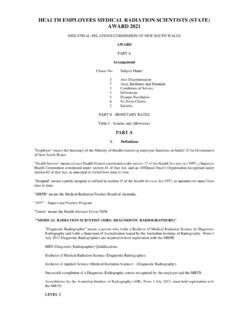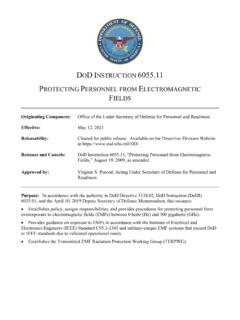Transcription of Access to Medical and Exposure Records
1 Access to Medical and Exposure Records Department of Labor Occupational Safety and Health Administration OSHA 3110 2020 (Revised) This booklet provides a generic overview of a standards- related topic. This publication does not alter or determine compliance responsibilities, which are described in the OSHA standards and the Occupational Safety and Health Act. Because interpretations and enforcement policy may change over time, the best sources for additional guidance on OSHA compliance requirements are current administrative interpretations and decisions by the Occupational Safety and Health Review Commission and the courts. This publication is in the public domain and may be reproduced fully or partially without permission. Source credit is requested but not required. OSHA will make this information available to sensory impaired individuals upon request. Call (202) 693-1999. Who should read this booklet?
2 If you are an employee who has a possible Exposure to or uses toxic substances or harmful physical agents at your work site or an employer who has employees that may be exposed, you need to know your rights and responsibilities under OSHA s standard on Access to employee Exposure and Medical Records [Title 29 of the Code of Federal Regulations (CFR) Part ]. 1 If you are an employee who may have been exposed to toxic substances or harmful physical agents in the workplace, OSHA s regulation may help you detect, prevent, and treat occupational disease. You have the right to Access relevant Exposure and Medical Records and to know how OSHA s standard covers you if you are any of the following: A current or former employee who is or may have been exposed to toxic substances or harmful physical agents. An employee who was assigned or transferred to work involving toxic substances or harmful physical agents.
3 The legal representative of a deceased or legally incapacitated employee who was or may have been exposed to toxic substances or harmful physical agents. Designated employee representatives may Access employee Medical or Exposure Records and analyses created from those Records only in very specific circumstances. Designated employee representatives include any individual or organization to whom an employee has given written authorization to exercise a right of Access . 1 Particular circumstances may vary for Access to Medical and Exposure Records . Refer to the provisions of the OSHA standard for specific information and requirements. What types of exposures should I be concerned about? The standard covers Records documenting the amount of employee Exposure to toxic substances and harmful physical agents. Toxic substances and harmful physical agents may include the following:2 Metals and dusts, such as, lead, cadmium, and silica.
4 Biological agents, such as bacteria, viruses, and fungi. Physical stress, such as noise, heat, cold, vibration, repetitive motion, and ionizing and non-ionizing radiation. What is Access ? Access means the right to examine and copy Medical and Exposure Records . As an employee , you have the right to Access Exposure and Medical Records and analyses based on these Records that concern your employment. An employer must permit employees and, in certain circumstances their designated representatives, to Access Exposure and Medical Records relevant to the employee , free of charge, within a reasonable period of time. As an employee , you and your designated representatives may Access your Medical and Exposure Records in one of three ways: The employer may give you a copy of the document, or The employer may provide facilities for you to copy the document, or The employer may loan you the document to copy it offsite.
5 2 According to OSHA s regulation, toxic substance or harmful physical agent posing a hazard to human health must either (1) be listed in the latest edition of the NIOSH Registry of Toxic Effects of Chemical Substances, (2) have yielded positive evidence of an acute or chronic health hazard in testing conducted by or known to the employer, or (3) be the subject of a safety data sheet (SDS) kept by or known to the employer indicating that the material may pose a hazard to human health. As an employee , what types of Records can I Access ? You may Access any employee Exposure Records that show the measuring or monitoring of your own Exposure to a toxic substance or harmful physical agent. If your employer does not have any Records that specifically chart your own Exposure levels, you may Access the Exposure Records of employees who engage in similar work or working conditions and may have experienced exposures similar to yours.
6 employee Exposure Records include the following: Monitoring results of workplace air or measurements of toxic substances or harmful physical agents in the workplace, including personal, area, grab, wipe, or other forms of sampling results. Biological monitoring results, such as blood and urine test results. Safety data sheets (SDSs) containing information about a substance s hazards to human health. You also may Access any employee Medical Records concerning your health status that were created or maintained by a physician, nurse, health care professional, or technician. employee Medical Records include the following: Medical and employment questionnaires or histories. Results of Medical examinations and laboratory tests. Medical opinions, diagnoses, progress notes, and recommendations. First-aid Records . Descriptions of treatments and prescriptions. employee Medical complaints. In addition, you may Access any analyses compilations of data or statistical studies of employee Medical and Exposure Records that concern your working conditions or workplace.
7 If an analysis includes information that could be used to directly or indirectly identify individual employees, however, the employer is required to remove these identifiers to the extent possible before permitting employee Access to the analysis. Examples of identifiers include an employee s name, address, social security number, and job title. What types of Records can a designated employee representative Access ? The OSHA standard recognizes two types of designated representatives: (1) an individual or organization to whom the employee has given written authorization to Access his or her Medical or Exposure Records , and (2) a recognized or certified collective bargaining agent. To Access employee information, employee representatives must follow very specific requirements, such as the following: employee Exposure Records . Recognized or certified collective bargaining agents may Access employee Exposure Records without individual employees written consent.
8 The designated representative must request Access in writing from the employer, however, and must specify the Records to be disclosed and the occupational health need for accessing the Records . employee Medical Records . Designated representatives may Access the Medical Records of any employees who have given the representative specific written consent. As with employee Access to Medical Records , Access is limited to those Records pertaining to the authorizing employees. As an employer, what do I need to know about this standard? If you are an employer, you must do the following: Preserve and maintain accurate Medical and Exposure Records for each Inform workers of the existence, location, and availability of those Medical and Exposure Records . Give employees any informational material regarding this standard that OSHA makes available to you. Make Records available to employees, their designated representatives, and to OSHA, as required.
9 Analyses. For the purpose of analyses using Exposure or Medical Records , recognized or certified collective bargaining agents may Access the Records without individual employee s written consent. As with employee Access , however, the employer must remove or prevent Access to any information in these analyses that could reasonably be used to identify the individual employees whose Records are the subject of the analyses. Do employers have to make all Records available? No. If you are an employer, the following are not considered Medical Records under this standard: Physical specimens, such as blood and urine samples. Records concerning health insurance claims if they are (1) maintained separately from your Medical program and its Records , and (2) not accessible by employee name or other personal identifier ( , social security number or home address). 3 The Americans with Disabilities Act of 1990 (ADA), 42 12112(d)(3)(B)-(C) generally requires employers to keep employee Medical information confidential.
10 Equal Employment Opportunity Commission (EEOC) standards, however, do not prohibit employers from making the disclosures required by OSHA s Medical Access standard. For further information on ADA standards regarding employee Medical Records , contact the EEOC at Records created only for use in litigation that are privileged from discovery. Records created as part of voluntary employee assistance programs, such as Records for alcohol and drug abuse or personal counseling, if they are maintained separately from your Medical program and its Records . Trade secret information involving manufacturing processes or a percentage of a chemical substance in a mixture, as long as you inform health professionals and employees and their designated representatives that you have deleted that information from Medical and Exposure Records . If the exclusion of the trade secret information substantially impairs the evaluation of when and where the Exposure occurred, however, you must provide alternative information to the employee consistent with the requirements of 29 CFR Part What if I do not have Exposure Records for a particular employee ?











